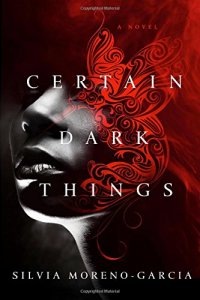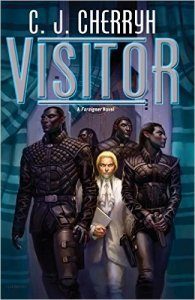John Langan reviews Silvia Moreno-Garcia
Certain Dark Things, Silvia Moreno-Garcia (Thomas Dunne Books 9781250099082, $25.99, 336pp, hc) October 2016.
 The world of Certain Dark Things, Silvia Moreno-Garcia’s fast-moving new novel, is one in which the existence of vampires has been an established and accepted fact for the last four decades. Some countries met this revelation by expelling vampires from their borders, others, by placing them under strict control. In response, many vampires relocated to more accommodating places, although doing so frequently brought them into conflict with any vampires already residing there. Not only do vampires exist in Moreno-Garcia’s world, but they do so in a variety of (at least) ten types, each connected to a different geographic area. They are folklore made flesh, and their interactions are fraught with tension, liable to violence. (There’s a passing resemblance to the universe of Kim Newman’s Anno Dracula books, but his reference points are primarily literary and filmic, whereas Moreno-Garcia’s are anthropological.) It’s a complex, dynamic setting, and one of the pleasures of Certain Dark Things lies in watching its author explore its parameters. Vampires do not exist in sufficient numbers here to change human history as significantly as is the case in, say, Justin Cronin’s Passage trilogy; rather, their effect has been more multifarious.
The world of Certain Dark Things, Silvia Moreno-Garcia’s fast-moving new novel, is one in which the existence of vampires has been an established and accepted fact for the last four decades. Some countries met this revelation by expelling vampires from their borders, others, by placing them under strict control. In response, many vampires relocated to more accommodating places, although doing so frequently brought them into conflict with any vampires already residing there. Not only do vampires exist in Moreno-Garcia’s world, but they do so in a variety of (at least) ten types, each connected to a different geographic area. They are folklore made flesh, and their interactions are fraught with tension, liable to violence. (There’s a passing resemblance to the universe of Kim Newman’s Anno Dracula books, but his reference points are primarily literary and filmic, whereas Moreno-Garcia’s are anthropological.) It’s a complex, dynamic setting, and one of the pleasures of Certain Dark Things lies in watching its author explore its parameters. Vampires do not exist in sufficient numbers here to change human history as significantly as is the case in, say, Justin Cronin’s Passage trilogy; rather, their effect has been more multifarious.
This is the case with Mexico, where the novel’s action takes place. The northern part of the country is inhabited by a number of different vampire species, most significantly the Tlahuihpochtin, the indigenous vampires of Central America, and the Necros, which have immigrated from central Europe. A series of escalating acts of violence between a Tlahuihpochtin family and a Necros family leads to the devastation of the native vampires; the sole survivor flees to Mexico City, the scion of the Necros in hot pursuit. Vampires are prohibited from the Mexican capital and its surroundings, a ban which is enforced by both the police and the local criminal organizations. It’s a case of out-of-the-frying-pan-into-the-fire for Atl, the novel’s vampire protagonist.
Fortunately for her, she draws the attention of Domingo, a teenaged garbage collector who is the book’s human protagonist. A member of the city’s vast underclass, Domingo is fascinated by vampires, his (largely inaccurate) knowledge of which is drawn from comic books and movies. His knowledge of the city, though, and of how to move around it discreetly, is spot-on, and of sufficient use to Atl for her to decide not to kill him for his blood. Instead, she partners with him as she tries to find a way out of the city and, ultimately, the country.
This partnership is paralleled by that between Nick, the novel’s vampire antagonist, and Rodrigo, its human antagonist. Nick is a monster of appetite, of his overwhelming desire for extravagant revenge on Atl for the losses she has cost him and his family. It is the duty of Rodrigo, who serves Nick’s father, to ensure that Nick does not destroy himself in the process. The vampire and human’s relationship is defined by mutual contempt, each fantasizing about murdering the other.
But where it’s tempting to view Nick and Rodrigo’s partnership as the opposite of Atl and Domingo’s, the reality is more complicated. Atl’s attitude towards Domingo has more than a touch of condescension to it, and, until quite late in the novel, she is very aware of him as an easily available source of the blood that sustains her. This is not a Twilight-style romance. Yet neither is Atl’s perspective on Domingo static. Rather, as the narrative develops, so does her understanding and appreciation of her human companion, her sympathy gradually expanding to include him. In the midst of the ongoing chase narrative, the broadening of Atl’s sensibilities gives the novel added heft.
That chase extends throughout Mexico City. As the novel presents it, the city is the apotheosis of the roman noir setting: the rich bunkered behind walled subdivisions, the police corrupt and inefficient, rival gangs working covertly and sometimes openly to advance their agendas. It’s a place of hidden tunnels known only to the poor, of an old house in which an even older creature measures his days. The city’s Aztec origins connect it to Atl’s type of vampire, who once served religious functions within Aztec culture, but the subsequent centuries of construction that have submerged the original city offer an architectural trope for the status of the Tlahuihpochtin in the contemporary world.
As the narrative unfolds, so Atl’s role in the destruction of her family becomes clearer, to us and to her. In part due to Domingo’s questions about her past, the vampire must confront and reckon with the consequences of actions undertaken in the arrogance of youth and privilege, and must accept her culpability for the death of her loved ones. Together with her deepening attitude towards Domingo – who is himself growing as a character – this shift brings Atl out of callow inexperience to a maturity that manifests in a surprising act of renunciation at the novel’s climax.
With Certain Dark Things, Silvia Moreno-Garcia demonstrates that there is always more to be done with familiar figures such as the vampire, and that in the hands of a talented writer, the creatures can rise to new (un)life. It’s perhaps a familiar lesson, but one that’s conveyed in a dynamic and compelling way.







